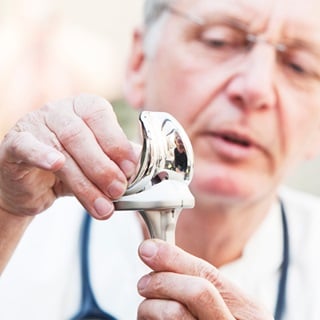Osteoarthritis of the Knee

Overview
A normal knee glides smoothly because cartilage covers the ends of the bones that form joints. Osteoarthritis of knee damages this cartilage, progressively wearing it away. The ends of the bones become rough like sandpaper. This damaged cartilage can cause the joint to "stick" or lock and your knee may get painful, stiff and lose range of motion.
Our Approach to Osteoarthritis of the Knee
When treating knee osteoarthritis, our goals are to relieve pain and restore normal movement. We begin with nonsurgical treatments, such as medications and physical therapy. If these prove ineffective, surgery may help. Surgical options include realigning the joint or replacing it with an artificial implant. Either procedure can significantly reduce pain and improve function.
UCSF's team of highly trained orthopedic surgeons includes specialists in joint replacement. Using the latest techniques and technology, they perform more than 800 hip and knee procedures each year on patients who come to UCSF from all over the world.
Awards & recognition
-

Among the top hospitals in the nation
-

Best in Northern California and No. 6 in the nation for orthopedic care
-

Rated high-performing hospital for knee replacement
Signs & symptoms
If your knee is severely damaged by arthritis or injury, it may be hard for you to perform simple activities such as walking or climbing stairs. You may even begin to feel pain while you're sitting or lying down. Symptoms may include severe knee pain that limits your everyday activities, including walking, going up and down stairs and standing up from a chair. You may find it hard to walk more than a few blocks without significant pain and you may need to use a cane or walker. You may also experience:
- Moderate or severe knee pain while resting, day or night.
- Chronic knee inflammation and swelling that doesn't improve with rest or medications.
- Knee deformity, a bowing in or out of your knee.
- Knee stiffness or the inability to bend and straighten your knee.
An additional symptom may be failure to get pain relief from non-steroidal anti-inflammatory drugs. These medications, including aspirin and ibuprofen, often are most effective in the early stages of arthritis. Their effectiveness varies from person to person and may become less effective for patients with severe arthritis.
Diagnosis
Your surgeon will take your medical history, gather information about your general health and ask you about the extent of your knee pain and your ability to function. A physical examination will be taken to assess your knee motion, stability and strength and overall leg alignment. X-rays may be performed to determine the extent of damage and deformity of your knee. Occasionally, blood tests, an MRI (magnetic resonance imaging) or a bone scan may be needed to determine the condition of the bone and soft tissues of your knee.
Treatments
Medications, changing your activity level and using walking supports may be helpful but if these are not effective, you may want to consider knee surgery. Inability to tolerate or complications from pain medications or failure to substantially improve with other treatments such as cortisone injections, physical therapy or other surgeries may suggest a knee operation. There are two surgical treatments for osteoarthritis of the knee.
An osteotomy is surgery that reshapes the shinbone (tibia) or thighbone (femur) to improve your knee's alignment. The healthy bone and cartilage is realigned to compensate for the damaged tissue. Knee osteotomy surgically repositions the joint, realigning the mechanical axis of the limb away from the diseased area. This lets your knee glide freely and carry weight evenly. Osteotomies may restore knee function and significantly diminish osteoarthritis pain.
Total knee replacement surgery is another procedure that can help relieve your pain, correct your leg deformity and help you resume your normal activities. This procedure calls for removing the damaged cartilage and bone and inserting new metal and plastic joint surfaces to restore the alignment and function of your knee. The decision to have total knee replacement surgery should involve you, your family, your family physician and your orthopedic surgeon.
UCSF Health medical specialists have reviewed this information. It is for educational purposes only and is not intended to replace the advice of your doctor or other health care provider. We encourage you to discuss any questions or concerns you may have with your provider.













